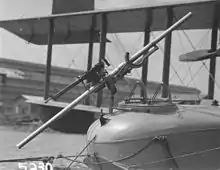Davis gun
The Davis gun was the first true recoilless gun developed and taken into service. It was developed by Commander Cleland Davis[1] of the United States Navy in 1910, just prior to World War I.
| Davis Gun | |
|---|---|
 Davis gun mounted on Curtiss F5L anti-submarine seaplane | |
| Type | Recoilless cannon |
| Place of origin | United States |
| Service history | |
| Used by | Royal Naval Air Service |
| Wars | World War I |
| Production history | |
| Designer | Cleland Davis |
| Designed | 1912–1914 |
Development

Davis' design connected two guns back to back, with the backwards-facing gun loaded with lead balls and grease of the same weight as the shell in the other gun, acting as a counter. His idea was used experimentally by the British and Americans as an anti-Zeppelin and anti-submarine weapon[3] mounted on the British Handley Page O/100 and O/400 bombers and the American Curtiss Twin JN[1] and Curtiss HS-2L and H-16 flying boats. The direct development of the gun ended with the end of World War I in November 1918, but the firing principle has been copied by later designs.
Description
The gun was made in three sizes: 2-pounder, 6-pounder and 12-pounder; 1.57 in (40 mm), 2.45 in (62 mm),[4] and 3 in (76 mm) in caliber respectively, firing 2-pound (0.91 kg), 6-pound (2.7 kg), and 12-pound (5.4 kg) shells. The 3-inch gun carried a pressure of 15 tons per square inch (2,109 kg per cm2) when fired. Usually a Lewis machine gun was mounted on top of the Davis gun's barrel for use in sighting and as an auxiliary and anti-aircraft weapon.
Aircraft used
The gun was tested on various aircraft and some aircraft were designed to carry the gun:
- Airco DH.4
- Armstrong-Whitworth FK.5 and FK.6 - "escort fighter" triplane
- Curtiss F5L - patrol flying boat used by US Navy
- Felixstowe Porte Baby - large flying boat
- Handley-Page O/100 - twin engined bombers with 6pdr Davis gun added for ground attack and anti-submarine
- Handley-Page O/400 - larger version of the O/400
- Naval Aircraft Factory N-1 - patrol floatplane designed by US Navy, four prototypes built, project canceled[6]
- Short Type 184
- Short 310-B seaplane
- Pemberton-Billing PB.29E
- Pemberton-Billing PB.31E - long endurance anti-Zeppelin night fighter with 37mm Davis gun, prototypes only
- Robey-Peters RRF.25 Gun-carrier - two Davis guns. Single prototype for Royal Navy completed
Surviving examples
There are examples at the Naval Aviation Museum at Pensacola, Florida, the Imperial War Museum in London, and the Kentucky Historical Society in Frankfort, Kentucky.
See also
References
- Williams, Anthony G (August 2014). "The Cannon Pioneers: The early development and use of aircraft cannon". Retrieved 28 December 2021.
- United States. Navy Dept. Bureau of Ordnance (1923). Ammunition : instructions for the naval service, 1923. Washington, D.C.: Government Printing Office. p. 162.
- "DAVIS AMMUNITION". www.big-ordnance.com. Retrieved 19 November 2012.
- Williams give 57mm calibre
- Trimble, William F. (1990). Wings for the Navy: A History of the Naval Aircraft Factory, 1917-1956 (1st ed.). Annapolis, Maryland: Naval Institute Press. pp. 35–36. ISBN 0-87021-663-5.